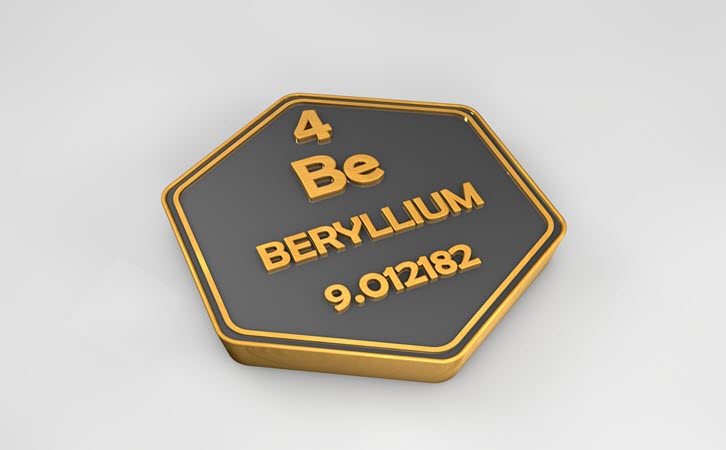OSHA’s New Proposed Rule on Beryllium: What You Should Know
12/13/2018

OSHA has issued a proposed rule to revise the beryllium standard for general industry. The rule, published in the Federal Register on December 11, 2018, seeks to clarify the standard and simplify and improve compliance for employers.
Let’s take a closer look at the proposed rule and its potential impact on your business.
The Background
Beryllium is a strong, lightweight metal commonly used in the manufacture of electronic components, and in structural alloys for the defense and aerospace industries. Overexposure to the metal can cause serious health risks, including incurable chronic beryllium disease (CBD) and lung cancer. OSHA estimates that 62,000 workers are exposed to beryllium each year, and has projected that the updated regulations will save 90 lives from beryllium-related disease and prevent 46 new cases of CBD each year.
To better protect workers from beryllium exposures, OSHA published a final rule on Occupational Exposure to Beryllium and Beryllium Compounds in 2017, with separate standards for general industry, shipyards and construction.
Most notably, the 2017 rule establishes a new permissible exposure limit (PEL) of 0.2 micrograms of beryllium per cubic meter of air (µg/m3), measured as an 8-hour time-weighted average (TWA) concentration. The rule also establishes an Action Level (AL) of 0.1 µg/m3and a short-term exposure limit (STEL) of 2.0 µg/m3as measured over a 15-minute sampling period. The rule mandates that employers must use engineering and work practice controls to reduce airborne concentrations of beryllium to levels below the PEL and STEL.
The rule includes other provisions to protect employees from beryllium exposure, including requirements for employers to limit access to high-exposure areas, provide respiratory protection to workers when necessary, develop and implement written exposure control plans, and provide workers with training. The rule also requires employers to offer free medical examinations to workers under certain conditions, including exposures above the AL for 30 days in one year, signs of symptoms of CBD, or recommendations for medical surveillance by a physician or other licensed health care professional (PLHCP).
Following OSHA’s publication of the 2017 rule, stakeholders raised concerns with the definition of a “beryllium work area” which was defined by the 2017 rule as “any work area containing a process or operation that can release beryllium where employees are, or can reasonably be expected to be, exposed to beryllium at any level or where there is the potential for dermal contact with beryllium.” Opponents of these provisions maintained this broad definition could be interpreted to apply to areas containing only trace levels of beryllium.
In response to these criticisms, OSHA signed a settlement agreement in April 2018 with petitioners in which the agency resolved to take a number of actions to clarify and improve the beryllium standard. OSHA has since already taken many of these measures, including delaying the compliance date for some requirements until December 12, 2018, and publication of a direct final rule (DFR) in May 2018 to clarify the beryllium standard.
The New Proposed Rule
OSHA’s new proposed rule satisfies the April 2018 settlement agreement by making additional clarifications and refinements to the rule. The proposal would amend selected paragraphs of the standard, including “Definitions,” “Methods of Compliance,” “Personal Protective Clothing and Equipment,” “Hygiene Areas and Practices,” “Housekeeping,” “Medical Surveillance,” “Hazard Communication and Recordkeeping.” It would also add new terms to the “definitions” section of the standard, and would remove the existing Appendix A, which lists suggested controls, and replace it with a new Appendix A called “Operations for Establishing Beryllium Work Areas.”
OSHA believes that the proposed changes to the standard will provide equivalent protection to workers, while ensuring that requirements are well-understood. OSHA states that comments on the proposed rule must be submitted by February 9, 2019.
While this rulemaking is pending, OSHA will evaluate facilities for compliance based on their adherence to the standard as modified by the proposed rule. If your business is in general industry, you should familiarize yourself with the revised requirements of the rule, and make sure you’re meeting your obligations. Getting a handle on your operations and chemical inventory to identify all areas where beryllium is used would be an excellent place to start.
Let VelocityEHS Help!
MSDSonline chemical management solutions from VelocityEHS can help covered employers meet the Hazard Communication requirements of OSHA’s beryllium standard by ensuring your employees have access to GHS-formatted SDSs, labels and hazard training.
Our award-winning MSDSonline HQ and HQ RegXR Accounts provide 24/7 mobile-enabled, employee right-to-know access to the industry’s leading database of SDSs, and feature built-in GHS workplace labeling capabilities, including workplace label integrations with Brady, Avery and DuraLabel from Graphic Products. With ingredient indexing capabilities, you’ll be able to identify all products containing beryllium in your inventory, and be well-prepared to begin assessing employee exposure levels as required under the beryllium standard.
In addition, the VelocityEHS Risk Analysis solution can help streamline the identification of areas where exposure to beryllium may occur, as well as the assignment and tracking of follow-up actions.
If you’re looking for an easier way to schedule, conduct and manage the inspections needed to comply with the housekeeping requirements of the beryllium rule, our Audit & Inspections solution provides a powerful, yet easy-to-use system that simplifies every aspect of inspection program management — from planning and scheduling, to evaluation, corrective actions and reporting.
With the right tools, you’ll be prepared for compliance with OSHA’s beryllium rule, and ready to take your workplace safety performance to the next level. Request a Demo of our award-winning solutions today, and see why more than 14,000 businesses and 8 million users worldwide trust VelocityEHS to help meet their EHS management needs and build a safer, more sustainable workplace.






